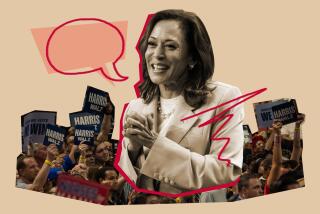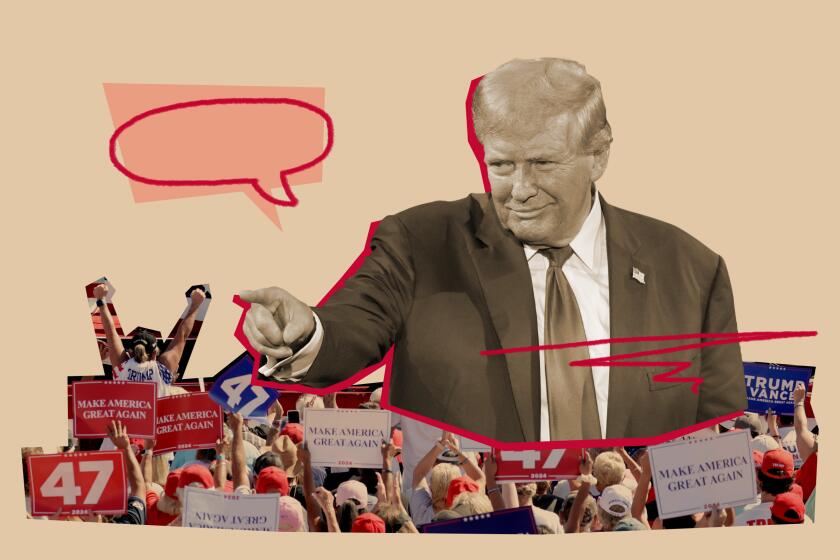Democrats go bold on economic plans, a deliberate contrast to 2016
Reporting from Washington — Asked what her very first act as president would be, Sen. Kamala Harris had a quick answer at a recent televised town hall: Enact a tax cut that would boost incomes for working families by as much as $6,000 a year.
Sen. Elizabeth Warren followed the launch of her campaign by unveiling a tax on the super-rich that backers say could raise as much as $275 billion a year.
Sen. Cory Booker, who entered the race last week, touts his plan for government-paid trust funds for every American baby, which supporters say could dramatically shrink the racial wealth gap.
Candidates in primaries battle with their personalities and life stories. Campaigns, however, also serve as contests of ideas, especially for a party trying to redefine itself after a traumatic defeat.
As the Democratic field takes shape this winter, the ideas primary is well underway. Plans for expanded healthcare coverage, efforts to combat global warming and reform of the political system all compete for attention.
But many of the ideas gaining the most traction share a common theme: How can the U.S. combat growing inequality of wealth and stagnation of wages for low- and middle-income workers, problems that have dominated the economic landscape for much of the last two decades?
The drive to come up with boldly stated economic policies reflects a lurch of the Democratic Party to the left since President Trump’s election. The shift involves political risk, potentially reviving a debate over “big government” that Democrats backed away from a generation ago.
Trump made clear in his State of the Union speech on Tuesday the line of attack he hopes to use against whichever Democratic nominee emerges: “We are born free, and we will stay free,” he declared. “America will never be a socialist country.”
But the new crop of Democratic candidates clearly believes the country’s mood has shifted, if not to socialism, then at least a few steps toward a more Western European social democracy.
Even in the midst of low unemployment, voters’ economic insecurity and fear that opportunities are disappearing for their children shape their views, said Lanae Erickson, senior vice president for policy at Third Way, a centrist Democratic group based in Washington. Across the party’s ideological spectrum, Democratic activists believe that Hillary Clinton failed in 2016 to connect with that concern.
This time around, Erickson said, “everyone knows they’ll need some big ideas.”
Taken together, those ideas say a lot about the state of the economic debate among Democrats.
“I worked for the Obama administration, and I’m proud of what we did,” said Jared Bernstein, who was Vice President Joe Biden’s economic advisor. But among Democratic activists, whether fairly or not, “there’s a sense that our solutions were constrained.”
Some of the drive to think big represents a reaction against “the boldness and baldness of the right-wing agenda,” including the 2017 tax cut, which gave the lion’s share of its benefits to the already well-off, said Connie Razza, vice president of policy at Demos, an advocacy group on the Democratic left.
“Continuing to put forward things that are incremental is not enough,” she said. “We need policies that match the aspirations of the country.”
While the main Democratic hopefuls share many ideas, their signature proposals highlight differences among them, both in what they choose to emphasize and in their approaches to policy making.
The Democratic field: Who’s running, who’s on the fence? »
Booker’s so-called baby bonds plan reflects his long-standing interest in narrowing the racial gap in wealth: The average black family has less than one-tenth the assets of the average white family, a legacy, in part, of government policies that for decades aided whites but often hindered blacks in purchasing homes, which are the biggest asset for most families.
He would provide a government account worth $1,000 to each newborn, then add more each year for children of low- and middle-income families, up to a maximum of $2,000 a year for the lowest-income families. The money would flow until age 18. By then, with interest, the accounts would be worth as much as $46,000, and young people could use it for specific purposes, including paying for college or buying a house.
Harris’ tax plan, the LIFT Act, which she introduced in the Senate last fall, would massively increase the government’s effort to improve the economic conditions of low- and middle-income families, providing help to many middle-income families that earn too much for existing programs.
Many policy analysts on the left argue that such a move is needed because of changes in the global economy that relentlessly push down wages for many workers.
“There’s a real divide in the country that we have not seen before” with “too many families that are one paycheck away from going into debt,” Harris said in an interview.
Modeled after the decades-old Earned Income Tax Credit, which is already the government’s most successful anti-poverty program, the proposal would match the first $3,000 in earnings for individual workers, $6,000 for married couples. A married couple with income up to $60,000 would get the full amount, with less going to families with incomes up to $100,000.
The money would come in the form of a tax credit that would be refundable, meaning that people who owe zero in income tax would receive a check.
The plan has drawn broad support from Democratic policy analysts. Centrists like that the benefit matches earnings from work, rebutting the accusation of a “giveaway.” The plan fits into the long Democratic tradition of “making work pay,” said Erickson of Third Way.
Razza and others on the party’s left praise the idea for providing an immediate, tangible benefit. Families “have to live this year and next year,” she said.
About half of all middle-income households — families earning between $50,000 and $87,000 a year — would get a tax cut under Harris’ plan, according to an analysis by the nonpartisan Tax Policy Center. (For married-couple families in the U.S., the median income — the midpoint of the income ladder — was just over $90,000.) For those lower down the income ladder, her plan would boost some 6.2 million Americans out of poverty, according to an estimate by analysts at Columbia University’s Center on Poverty and Social Policy.
It would also be very expensive.
At roughly $250 billion in its first year and $3 trillion over a decade, the plan would cost about two-thirds of what the federal government spends on Medicaid, the safety net medical program for the poor, disabled and nursing home patients.
A commitment that size would almost surely require Democrats to defer some other goals, a point Harris concedes.
“There’s no question that there’s going to have to be some triage involved,” she said, adding that expanded support for middle-income families “would provide one of the greatest returns on the investment.”
The price tag is almost the same as that of the Republican tax-cut plan, and that cost “didn’t seem to stop anybody,” Bernstein noted. Harris has said she would offer ways to pay for her proposal, but so far has done so only partially.
Warren’s two main economic proposals, by contrast, do not involve large amounts of new federal spending — a deliberate move to avoid the “big spender” label that has hurt Democrats, according to advisors.
By some measures, however, her ideas would much more radically change the U.S. economy, in ways designed to reduce the clout of those at the top and rewire some of the fundamental rules of the marketplace.
Last fall, Warren released a plan that would rewrite the rules for big business. Corporations with revenue of more than $1 billion a year would be legally required to balance the interests of shareholders against those of employees, local communities and other stakeholders.
Warren would also give workers the right to elect 40% of the biggest companies’ boards of directors, a mandate similar to one in Germany.
Last month, she added another significant plan — a wealth tax of 2% a year on assets of more than $50 million and 3% on fortunes over $1 billion. The tax would hit about 75,000 families in the U.S. and could raise roughly $2.75 trillion over a decade, according to an estimate by UC Berkeley professor Emmanuel Saez, who helped draft the idea.
Warren’s plans already have drawn sharp criticism from the wealthy. Former New York Mayor Michael R. Bloomberg, a billionaire who has been pondering his own run for the nomination, said during a recent trip to New Hampshire that voters could see the impact of ideas like Warren’s by looking to another country in the hemisphere — “it’s called Venezuela.”
Even supporters say her changes in corporate rules would sharply lower stock prices, at least initially. And the wealth tax faces serious questions about its constitutionality.
Warren’s approach, however, illustrates her central argument that the power of concentrated wealth has led to a “rigged system” that hurts average families. It also reflects her background as a law professor and expert on how legal rules that shape the economy can have a profound effect on everyday life.
As far back as her childhood in Oklahoma, Warren recently told a crowd in Iowa, “I began to understand that the way the rules are set up makes a big difference in whether or not you get a chance to succeed.”
“For me, this is the fight of my life. I didn’t pick this because it poll-tested. I picked it because it picked me.”
More to Read
Get the L.A. Times Politics newsletter
Deeply reported insights into legislation, politics and policy from Sacramento, Washington and beyond. In your inbox three times per week.
You may occasionally receive promotional content from the Los Angeles Times.











